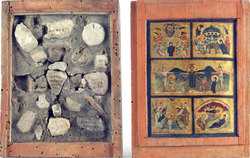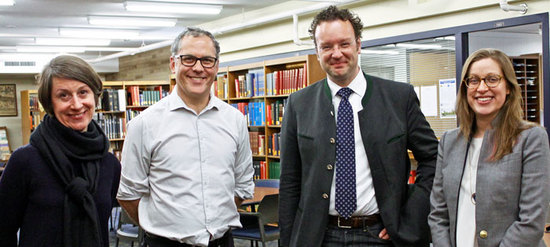2016-17 Medieval Institute Mellon Fellow Laura Veneskey Presents Her Work at the Annual Mellon Colloquium
Since 2001, through the generous response of the Andrew W. Mellon Foundation to a challenge grant awarded to Notre Dame by the National Endowment for the Humanities, the Medieval Institute has offered an A.W. Mellon Postdoctoral Fellowship in Medieval Studies to an outstanding young scholar to do research while in residence for the year at Notre Dame. This Fellowship is designed for junior faculty who currently hold a position in a United States university as an assistant professor and enables its holders to complete research and writing on a book manuscript in advance of tenure.
 Sancta Sanctorum Reliquary box (left: inner box, right: inner lid)
Sancta Sanctorum Reliquary box (left: inner box, right: inner lid)
This year's Mellon Fellow is Laura Veneskey, Assistant Professor of Ancient, Medieval, and Byzantine Art at Wake Forest University, working on a project entitled Earthly Icons: Between Matter & Figuration in Early Byzantine Art that, as she describes, "confronts the dynamic relationship between image and matter." On April 1st, the MI held its annual colloquium, an opportunity for the fellow and respondents to convene with the rest of the medievalist community at Notre Dame in an informal setting to evaluate and discuss the fellow’s book manuscript in progress. Veneskey presented a portion of her research focusing on the Sancta Sanctorum reliquary (pictured at right), a mysterious object commonly thought to be a pilgrimage souvenir with sixth- or seventh-century Syrian/Palestinian origins that now resides in the Vatican. In her work on the reliquary presented at the Colloquium, Veneskey considered questions of matter—the wax, earth, wood, and stone that make up the box—and the interplay of that matter with the subjects of the box, a symbolic imagining of the Crucifixion on the cover and other painted religious scenes on the inner lid.
 From left to right: Aden Kumler, Charles Barber, Holger Klein, Laura Veneskey (Mellon Fellow)
From left to right: Aden Kumler, Charles Barber, Holger Klein, Laura Veneskey (Mellon Fellow)
Responding to Veneskey’s work were Charles Barber, Professor of Art and Archeology, Princeton University; Holger Klein, Professor of Early Christian, Byzantine, and Western Medieval Art and Archaeology, Columbia University; and Aden Kumler, Associate Professor of Art History and the College, University of Chicago (pictured above). Following the morning’s colloquium, all attendees enjoyed lunch and further discussion of the presentations. In the afternoon, all three senior scholars met with Veneskey in an extended collegial session to discuss her manuscript.
There are few fellowships designed for this kind of support of tenure-track faculty; Veneskey notes that this Mellon Fellowship “fills a crucial need by providing both time to work on the manuscript and a forum for structured feedback. That it also offers the opportunity to cultivate substantive relationships with major scholars in one's field is another huge benefit, with the potential to extend well beyond the tenure of the fellowship.” Of the experience, she commented that “it would be hard to overstate the helpfulness of the colloquium itself. I received such thoughtful comments from everyone in attendance, and especially from my readers, who not only pushed my thinking in new directions, but also helped me to figure out ways to better accomplish what I set out to do in the first place. It can be so easy to accidentally jump the tracks while working alone a project of this scope, so getting to work through some big questions with them was a really clarifying experience. Not many fellowships out there are so thoughtfully designed that they actively improve one's work in this way.”
The MI has greatly enjoyed Prof. Veneskey's tenure here at the Institute and looks forward to the forthcoming publication of her book.
Updated by Rebecca West on November 14, 2017.